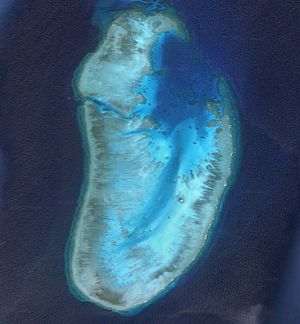As if tensions in the South China Sea weren’t high enough already, on Wednesday the Philippines’ Department of Foreign Affairs (DFA) accused China of conducting land reclamation and construction on Johnson South Reef, part of the disputed Spratly Islands. DFA spokesman Charles Jose told Reuters that China is moving earth and materials to the reef. “They’re about to build an airstrip,” he was quoted as saying. Other Philippine sources suggested China might be building a military outpost, such as a resupply or refueling station.
According to a statement from the DFA, the Philippines protested China’s reclamation of land on Johnson Reef on April 4, but China rejected the protest. It’s unclear why the Philippines waited over a month before deciding to publicly denounce the move. The DFA also said that it had raised the issue during last weekend’s ASEAN Summit, where the South China Sea issue was a major topic of discussion.
The Philippines believes that the construction project is in violation of the 2002 Declaration on the Conduct of Parties in the South China Sea. In that agreement, the ASEAN states and China agreed “to exercise self-restraint in the conduct of activities that would complicate or escalate disputes … including, among other, refraining from action of inhabiting on the presently uninhabited islands” or other features. Johnson Reef is already home to a number of buildings, including a maritime observation station.
China seemed to confirm that construction work on the reef is ongoing, but has not commented on what the final product will be. China’s Foreign Ministry spokesperson Hua Chunying told reporters that China was perfectly within its rights to carry out construction on the reef, which she called Chinese territory. She also questioned Manila’s motives for raising the issue.
According to an AP source, the Philippine government believes China’s reclamation project (including dredging operations) has changed Johnson Reef from a largely-underwater feature to a islet encompassing around 30 hectares. The enlargement could have larger ramifications than the construction itself, as an islet provides a stronger basis for a territorial claim than a reef.
Richard Bitzinger of the S. Rajaratnam School of International Studies in Singapore told Reuters that any airstrip built on Johnson South Reef would be “far too small to have a huge impact” strategically. Instead, he viewed the construction as an end in itself, “the laying down of one more marker to solidify [China’s] position.” Both the Philippines and Taiwan already have airstrips in the Spratlys —on Thitu Island for the Philippines and Taiping Island for Taiwan.
The Spratly Islands encompass over 750 islands, islets, reefs, and other features in the South China Sea. Different areas of the Spratlys are claimed by Brunei, China, Malaysia, the Philippines, Taiwan, and Vietnam. Johnson South Reef has been under Chinese control since a 1988 skirmish in the area, which left over 80 Vietnamese dead.































